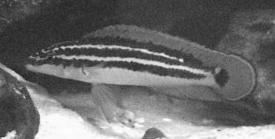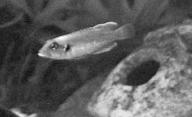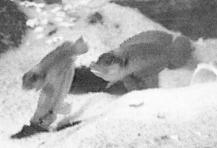
 Julidichromis ornatus
|
After several years and many generations of Julidochromis
ornatus in my 40 gallon plex tank it was time for something new. I
have always been intrigued by the shell dwellers from lake Tanganyika
so when Neolamprologus ocellatus gold
popped up in my local
shop, I bought eight of them. These little fishes are cute and
colorful. Somewhat stocky bodies with a yellow-gold color on the fins
and body, with a lavender sheen on the sides. Both have an orange spot
on the head. Being on the small side, it was difficult to distinguish
males from females so some larger and some smaller ones were
selected.
 Neolamprologus ocellatus
|
The tank already had a substrate of fine silica sand and a few handfulls of 2-3 mm gravel. The water chemistry was adjusted to match the high pH and carbonate hardness of the lake by the addition of rift lake salts from The Cichlid Exchange in Portland. Several shells of various sizes and some flower pot shards were provided as shelter and potential spawning sites at one end of the tank. The julies occupied the pile of rocks in the middle, and the gold ocellatus dove for the bed of shells as soon as they were released in the tank. At first the julies were curious about their new tank mates but didn’t seem to mind them as long as they stayed away from the rocks. The goldies were quick learners and stayed in the shells. They did go through some squabbles over shells but soon worked out their dominance hierarchy and relative peace reigned. Several weeks passed and growth was rapid on a diet of baby and adult brine shrimp, and flakes. I still wasn’t sure there were pairs. Two different aquarist friends thought that all were males so three of them were netted out and exchanged for what I thought were females. It turned out that two of the three actually were female. When almost full grown the males are about one half to three quarters inch larger than the females at one and one quarter inch, and have more lavender on the flanks. The edge of the dorsal fin is gold on the males but light in color on the females.

Now with some females to vie for, the dominant male excluded the other males keeping them at the opposite end of the tank. At this point I was sure there would soon be babies and sure enough there were half a dozen tiny slivers darting aroung the mouth of the shell. A whoop of excitement brought my son running to see what was up. We fed them some baby brine shrimp which they had no trouble eating with gusto, but never straying more than a few millimeters from their shell. Both parents are ferocious in their defence of their young. If you put your hand in the tank they will attack and bite you with determination that far outweighs their size. The female stays near or even inside the shell with the fry. She always goes in head first, and it’s comical watching her wiggle to back out of the shell. The male ranges about ten centimeters from the shell watching for any threat to the young.
Within a few days the fry began disappearing. Right away I suspected the julies even though i never observed one actually harassing the female or babies. Weeks went by and new batches of fry would appear and then vanish without a trace. The decision had to be made to remove the julies or transfer the goldies to their own tank if any fry were going to be raised. One day I removed all of the rocks, without disturbing the bed of shells, in order to catch the julies which were taken to a shop for credit. Within two weeks fry began to appear near the shell where the largest female hung out. At this point I removed the extra males in order to avoid any predation of the fry. With one male, two females, and several different sized young there is always some action in the tank. At about one quarter inch in size the babies disperse to other shells. I’m not sure if they do this on their own or if the mom kicks them out. More shells need to be provided as the population increases. The growth rate of the fry is very fast, each day they look a bit larger.
Small size, attractive colors, interesting habits, ease of spawning, and feisty attitude make this shell dweller an ideal fish for the beginner or experienced aquarist looking for something new to work with. They would do ok in a ten gallon tank, but I think a larger one will allow for more behaviors to be observed and fry to be raised. Tank height is not important since they stay near the substrate at all times unless threatened. Be sure to maintain good water quality by performing weekly but small water changes as Tanganyikans do not like large changes in water conditions.